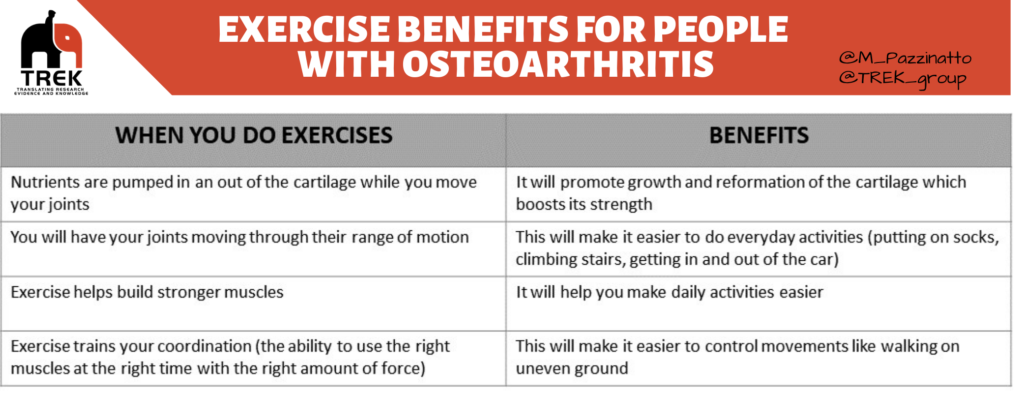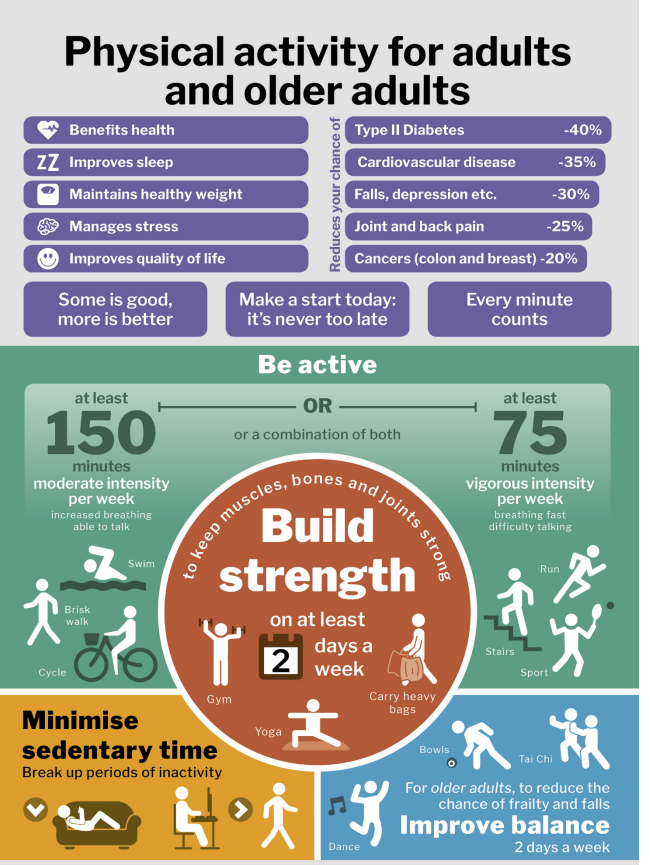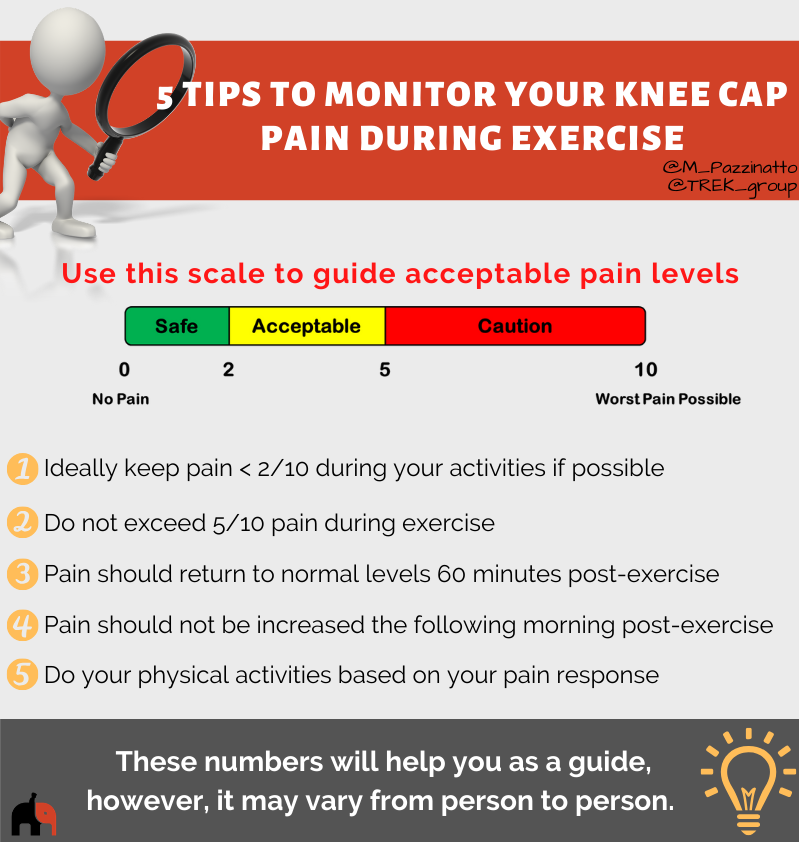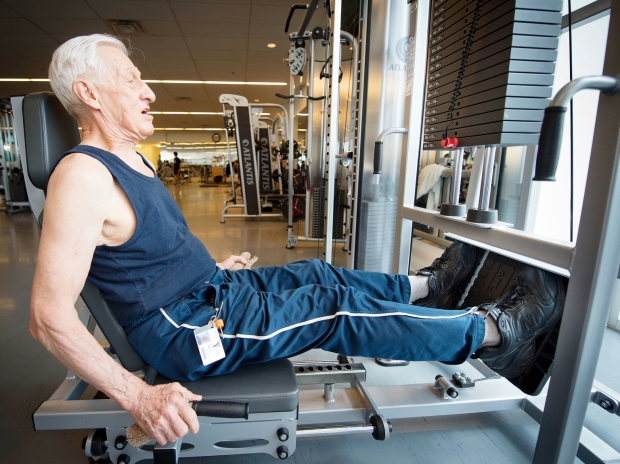Exercise and physical activity forms a crucial part of first-line treatment for people with knee osteoarthritis. Exercise and physical activity should be provided to all people with knee osteoarthritis regardless of age, pain levels, severity of the condition or co-morbidities.
Learn more about exercise and physical activity for people with knee osteoarthritis by watching our video with Dr. Allison Ezzat.
If you are interested about exercise and physical activity, we recommend that you add the ‘lifestyle and general health’ and ‘exercise’ sections to your personalised guide. Click here to get started and build your own.
Want to check if your programme is in need of progressing, or find the right exercises for you? Click on the links below
Frequently Asked Questions (FAQs)
Although similar, there are some subtle differences between these two words that are often used interchangeably.
Physical activity is any bodily movement produced by the skeletal muscles that results in a considerable increase over the energy expenditure at rest.
According to the World Health Organisation (WHO):
- Physical inactivity has the fourth leading risk factor for mortality globally.
- Globally, 1 in 4 adults are not active enough.
- More than 80% of the world’s adolescent population is insufficiently physically active.
Exercise is a specific type of physical activity that is planned, structured, and aims to improve one or more components of fitness (e.g. strength, endurance, flexibility).
Exercise is one of the best treatments for people who have trouble with their osteoarthritis and should be offered to anyone right away to help them self-manage their symptoms.
Exercise can reduce pain and, over time, improve function to make daily tasks easier. It’s also good for your body and mind and can lead to lots of positive things like a strong heart and good overall health.
The benefits of exercise disappear when you stop exercising. To keep the effects of exercise, you have to keep exercising regularly. This is why it’s important to do exercises that you enjoy. This will help make exercise part of your daily routine. Examples of exercises that might work well are: walking, running, aquatic (water) exercises, dancing, cycling, and strength training.

It is often suggested that people with knee osteoarthritis become more physically active (do more of the things you enjoy, such as gardening, shopping, cooking), whilst also supplementing this with regular structured exercise (such as running, walking, strengthening training). Being more physically active by doing things that you enjoy in your free time will keep you happy and improve your overall health. Being active can also help distract from the pain and, if weight is a factor, help you burn off more calories.
 World Health Organisation guidelines recommend the following for all people – with or without knee osteoarthritis to maximise overall health:
World Health Organisation guidelines recommend the following for all people – with or without knee osteoarthritis to maximise overall health:
For people aged 18-64 years old:
- A minimum of 150-300 minutes of moderate intensity aerobic physical activity or exercise per week OR
- A minimum of 75 minutes of vigorous intensity aerobic physical activity or exercise per week OR
- An equivalent combination of both PLUS
- A minimum of 2 strength training sessions per week PLUS
- limit the amount of time doing sedentary activities
For those aged 65 and above:
- The same guidelines as for people aged between 18-64 years old BUT
- Functional balance and strength training are recommended on 3 or more days a week, to enhance functional capacity and to prevent falls.
Remember these are a minimum. If you exceed these then often there are additional health benefits to be had.
There is no simple answer to this. In summary, medical guidelines suggest that people with knee osteoarthritis should engage in:
- Aerobic activity (for example hiking or cycling) in accordance with physical activity guidelines (in the above FAQ)
- Strength training of the leg and trunk muscles at least twice per week
This toolkit provides you with a few tools to help guide your exercise and physical activity:
- The exercise selector tool (to help you identify what program may be suitable for you)
- The exercise checker tool (to help check to see if you need to change anything in your current program)
- The personalised guide maker (if you include the ‘lifestyle and general health’ and ‘exercise’ sections) to help you keep track and monitor your progress over time
Research has found that exercise and physical activity has a positive effect on pain and function. How quickly or if you will respond positively to exercise is a difficult question to answer and is complicated. See more in our ‘understanding symptoms‘ page for more details on the complexity of pain.
To see true, long lasting changes in your strength may take a number of weeks or months. The key is to maintain an exercise and physical activity routine in the long term and gradually progress over time.
If you have osteoarthritis and start exercising, you might start to feel pain. The pain may last a while, but it’s not dangerous to keep exercising. Everybody reacts to pain differently. Some people stop activities completely and rest as much as they can, this can lead to even more lost function. Some people ignore pain signals, which can lead to more injuries.

Pain is the main reason people with knee osteoarthritis seek treatment. It’s also the main reason people with knee osteoarthritis avoid exercise. If you’re in pain you want to avoid activity, but being less active can make your pain worse over time. Inactivity causes muscle weakness, the knee might feel less stable, you can gain weight, and your mood and sleep problems can get worse. All of these things can make you avoid activity even more. It’s a vicious cycle.
It’s normal to feel a bit of pain when exercising. You may have a bit of muscle soreness if you haven’t used these muscles regularly, or have some joint pain. The muscle soreness will decrease as you get used to exercising. The joint pain should not go over your acceptable limit of pain (see figure). The joint pain should lessen 24 hours after exercise to the same level as before exercise. These pain limits will be different for everyone and can change over time. Reduce the intensity of your exercise if joint pain goes over your acceptable limit or continues for over 24 hours.
It’s important to listen to your body and strike a balance when exercising. Focus on your exercise goals to distract yourself from the pain. Don’t forget to have fun!
YES!!!
Most people with knee osteoarthritis can improve their pain and function by engaging in first-line care. This is great as it is a cost-effective way to manage your symptoms.
If you are looking for some guidance, either speak to your healthcare professional or create your own resource using our ‘personalised guide maker’ here. After deciding what you want in your guide you will be provided with a booklet (pdf) that you can either keep electronically to help you, or print it off and keep it as a guide to assist in your self-management.
Having trouble believing this? then check out the below videos of people who managed to avoid surgery by engaging with first-line treatments.
If you want to find out more about the GLAD program mentioned then click here
Many many people with knee osteoarthritis report having slips, trips or falls as a direct result of their condition. The below video takes you through some more information. If you want to find out more then ensure you select the ‘balance and falls’ section of our personalised guide maker
For further information about an exercise programme to specifically reduce falls risk, click here.
What are the exercise experiences of people with knee osteoarthritis?
Resources and additional information
Under construction
Next – Weight management



